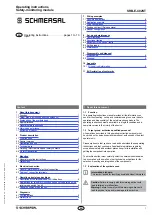
9
SRB-E-402ST
Operating instructions
Safety-monitoring module
EN
S31
S32
S41
S42 X5
S31
S
A
B
X7
X7
+24
VDC
+24
VDC
S32
+24
VDC
S42
X5
+24
VDC
S
A
B
X7
X7
+24
VDC
Rotary knob
position
Function
12
Two-hand function type IIIA
8. Set-up and maintenance
8.1 Commissioning
The safety relay module features protection class IP54 for installation in
a switch cabinet.
The safety relay module is delivered ready for operation.
Application 1 has already been preset in the factory for both safety
functions.
8.2 Functional testing
The safety function of the safety-monitoring module must be tested.
The following conditions must be previously checked and met:
1. Correct fixing
2. Check the integrity of the cable entry and connections
3. Check the safety-monitoring module's enclosure for damage
4. Check the electrical function of the connected sensor technology and
their influence on the safety-monitoring module and the downstream
actuators
The safety relay module features self-test functions.
If a fault is detected, the system adopts a safe mode and leads, if
necessary, to undelayed deactivation of all safety outputs.
8.3 Behaviour in the case of faults
In the event of a fault the following procedure is recommended:
1. Identify faults according to flash codes from chapter 6.2.
2. Rectify the fault if it is described in the table.
3. Switch operating voltage off and on and erase fault mode.
If fault could not be rectified, please contact the manufacturer.
8.4 Setting report
This report regarding the setting of the device must be completed
accordingly by the customer and enclosed in the technical
documentation of the machine.
The setting report must be available whenever a safety check is
performed.
Company:
The safety-monitoring module is used in the following machine:
Machine n°
Machine type
Module n°
Configured application (mode 1):
Configured application (mode 2):
Set on (date)
Signature of the responsible person
8.5 Maintenance
A regular visual inspection and functional test, including the following
steps, is recommended:
1. Check the correct fixing of the safety-monitoring module
2. Check the cable for damages
3. Check electrical function
Remark only relevant for relay outputs:
If a manual functional check is necessary to detect a
possible accumulation of faults, then this must take place
during the intervals noted as follows:
• at least every month for PL e with category 3 or
category 4 (according to ISO 13849-1) or SIL 3 with HFT
(hardware fault tolerance) = 1 (according to IEC 62061);
• at least every 12 months for PL d with category 3
(according to ISO 13849-1) or SIL 2 with HFT (hardware
fault tolerance) = 1 (according to IEC 62061).
Damaged or defective components must be replaced.
9. Disassembly and disposal
9.1 Disassembly
The safety-monitoring module must be disassembled in a de-energised
condition only.
9.2 Disposal
The safety-monitoring module must be disposed of in an appropriate
manner in accordance with the national prescriptions and legislations.
10.
Appendix
10.1 Wiring/circuit information
Use of safety outputs
Safety contacts 13/14, 23/24 (safety contact 1) and safety outputs Q1,
Q2 (safety function 2) work independently of each other. Depending on
the application, various hierarchies can be realised through external
wiring of the safety contacts and safety outputs.
Air clearances and creepage distances of the safety contacts
1
1
S11 S12 S21 S22
A1
A2
X3
X2
Q2
Q1
X7
Y1
S
R
B
-E
-4
02
ST
24
23
14
13
42
41
X5
X4
S31 S32 S41 S42
mode 2
mode 1
RUN
ERR
ln 1 / 2
ln 3 / 4
Out 1
Out 2
Against all other connection terminals, the safety contacts 13-14 and
23-24 comply without additional measures with the requirements for
double insulation in accordance with IEC/EN 60664-1 and are to be
used with switch voltages > 50 V.










